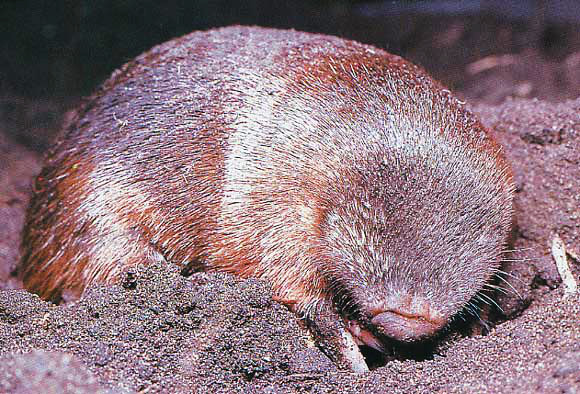
Dig down a few feet into Africa’s parched red soils and you might just encounter a burrowing biological oddity that has baffled scientists for two centuries. The golden moles (although, entirely unrelated to the more familiar ‘true’ moles) are a group of subterranean insectivorous mammals that live beneath a variety of forest, grassland and desert habitats across Southern and Eastern Africa. For years, they have defied taxonomists’ best attempts to place them on the tree of life and now they are causing conservationists a headache too.
Golden moles have several odd physiological traits, not least that their eyes are nonfunctional and sometimes covered with skin and fur. Instead, they rely mainly on the sense of touch and have become extremely sensitive to vibrations, which helps them find food and avoid predators. In fact, they have proportionally the largest inner ear bones of any mammal, meaning they can perhaps hear the incredibly feint movements of worms and insects wriggling through the soil.
As you might expect from a small mammal evolved for burrowing, they also have short, powerful legs for digging, webbed hind feet for shoveling loosened soil, dense fur and toughened skin. Unlike true moles, they do not not push soil up into mounds that we commonly recognize as molehills, instead they create long ridges above their tunnel systems. Yet despite their striking resemblance to other mole species (which fooled scientists for years), golden moles are an example of convergent evolution whereby unrelated species living in similar environments evolve similar features.
It is currently thought that there are about 21 different species of golden mole. Largely due to their elusive nature, we still know surprisingly little about them or their biology. Some, such as the Juliana’s golden mole (Neamblysomus julianae) live only in a few tiny regions of South Africa whilst the De Winton’s golden mole (Cryptochloris wintoni) has not been seen in over 50 years.
Even more mysterious is Visagie’s Golden Mole (Chrysochloris visagiei), which is only known from a single specimen. Despite two expeditions, during which not even local farmers recalled ever having seen a golden mole, no further specimens have been observed. It is possible that the location was incorrectly recorded, or perhaps the species is already extinct.
Overall, more than two thirds of golden mole species are listed as threatened or endangered and this situation is unlikely to improve in the near future. Yet there is some good news. Despite the majority of conservation attention being focused on large, furry above ground mammals, there is now at least some awareness of golden moles. Several species have been identified as worthy of urgent conservation attention by the Zoological Society of London’s EDGE programme, including the giant golden mole (Chrysospalax trevelyani), the largest known species.
They have even been featured in the title of a book ‘The Hunt for the Golden Mole’ which amongst other stories highlights the case of the enigmatic Somali golden mole (Calcochloris tytonis) which, incredibly, is known only from a fragment of jawbone discovered in a barn owl pellet in Giohar, Somalia in 1964. Whether this species still exists and what it looks like is anyone’s guess, but it does go to show that in conservation there are still many more questions than answers—especially when it comes to moles.
